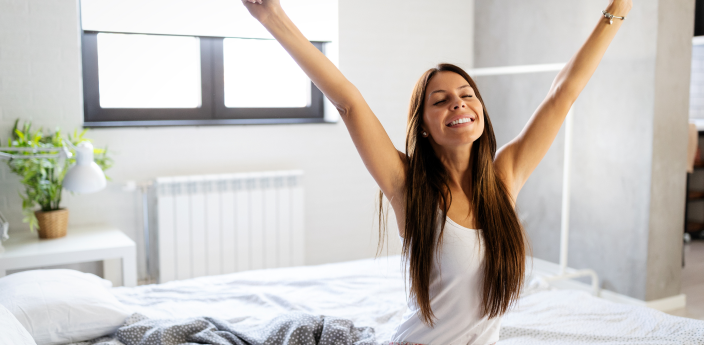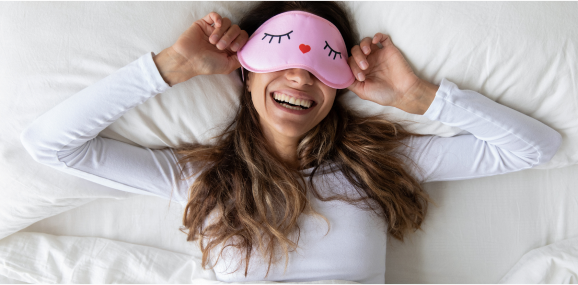Sleep is one of the most important things you can do for your health, but many Americans don’t get enough of it. If you feel like you’re having trouble getting to sleep or staying asleep, it might be time to rethink your nighttime routine.
Here’s how to switch things up to improve your comfort and increase your relaxation at nighttime.
1. Turn Down the Thermostat
When you’re asleep, you can’t adjust your temperature easily. If you’re a little too warm or cold, you’re probably going to wake up. The goal is to keep your sleeping environment cool enough that you won’t toss, turn, and kick off the covers — but warm enough that you won’t wake up shivering.
The perfect temperature can vary from person to person, but most experts recommend keeping things between 60 and 70 degrees Fahrenheit. The lower end of the spectrum might seem a little chilly, but keep in mind that the little cocoon you make with your blanket will help you retain body heat.
Fiddle around with your thermostat at night until you figure out how to dial it in just right. Some people find that sleeping with a fan helps because it circulates the air better, encouraging cool air to make direct contact with your skin.
2. Get Really Bored
Our bodies and our minds don’t always want the same thing. While your body might feel weary and ready to call it a night, your mind might still be bursting with ideas and craving stimulation. You can’t get to sleep if your brain is active and distracted.
The best thing to do before bed is to make yourself very bored. Get rid of all the distractions and leave yourself with nothing to focus on. If you aren’t playing video games, watching an episode of your favorite thriller, or catching up with your friends on social media, your brain will start to quiet down.
Many people find that meditation inspires a welcome kind of boredom. It’s a state of complete ease where you aren’t wound up or overwhelmed by the gears ticking in your head. You can meditate lying down in bed, and you might even fall asleep while you’re meditating.
You don’t need all the bells and whistles of formal meditation. All you need to do is get comfortable and acknowledge your thoughts without letting them linger. Don’t let your brain go down the rabbit hole of recounting everything you did today and everything you’ll need to do tomorrow; just watch the thoughts pass. They’ll still be there in the morning.
3. Pack All Your Energy Into the Morning
Things like coffee and exercise are a regular part of many people’s daily routine — and for good reason. Exercise is necessary for a healthy body, and a cup of coffee provides your body with things like cell-protecting antioxidants. It only becomes an issue when the energizing effects of these two things kick in when your body is trying to reach a less energetic state.
If you’re sensitive to caffeine, draw a line. The stimulant effects of caffeine can take several hours to completely wear off, so cut off the caffeine at least 6 hours before bedtime.
Exercise energizes your body, so you’re likely to feel more awake and alert for a few hours after you work out. If you’ve been hitting the gym after work, these effects can linger throughout the rest of your night.
Try switching to a morning workout. You might find that your early morning exercise routine helps you feel energized throughout the day. You may even be able to avoid your usual post-lunch slump due to the natural energy boost that exercise provides.
4. Put Your Phone Away
We use our phones everywhere — including our beds. While they’re a tempting distraction, they can disrupt sleep patterns in two ways.
The first is by distraction. If you’re reading, scrolling, or watching videos, you’re keeping your mind alert instead of giving it wind down.
The second is by emitting blue light. Your phone, your TV, and any other electronic device with a screen will emit blue light. Your brain can’t tell the difference between the blue light from your screens and sunlight, so it gets tricked into thinking it’s daytime.
Blue light can delay the release of your body’s natural sleep hormones. You need a prolonged period (an hour or two) without blue light stimulation for your body to begin its process of winding down for the night. Every minute you spend scrolling delays this process.
If you give up on trying to sleep and go back to your phone, this can start the process over again. It creates an infinite loop that pushes restful sleep further and further away.
Turning off your screens at least an hour before bedtime will give your body the time it needs to prepare itself to doze off.
5. Keep Yourself Emotionally Zen
If you’re up all night tossing and turning because you’re worrying, contemplating, or planning, you’re not going to be as productive as you’d like when you wake up.
It’s a good idea to have a plan for the following day… but it’s a great idea to lay your head down at night in an emotionally zen place. Let it all out of your head before you tuck yourself in.
Journaling or writing in a day planner is a great way to organize your mind. Write out your day and find a few things to feel grateful for, ending your day on a good note. Make a list of all the things you need to do tomorrow, and create a game plan.
When your head hits the pillow, it should be pleasantly empty. With your emotions and the day ahead both sorted out, you’ll be able to spend far less time contemplating and far more time sleeping.
If you often deal with negative feelings before bed, consider seeing a professional about your mental health. If you live with the daily obstacles posed by challenges like depression or anxiety, you deserve to find relief. You’ll sleep better, work better, and play better when you invest in your mental wellness.
6. Use Strategic Alarms
Adults need between seven and nine hours of sleep each night for a healthy mind and body. This starts with establishing the right bedtime and wake time. If it takes you about 20 minutes to fall asleep after you lay down, choose a bedtime that will allow you to sleep for a minimum of seven hours before your morning alarm.
You know how long it takes you to wake up and go through your morning routine before you need to go to work or tend to the day’s errands. Let your wake time determine your bedtime.
If you get distracted and caught up in your nighttime routine, it might be a good idea to set an alarm to tell you when it’s time to start getting ready for bed. Your bedtime won’t creep up on you if you give yourself the heads up.
If you wake up before your morning alarm, don’t reach for your phone. Try to go back to sleep until your alarm goes off. If you aren’t used to sleeping as much as you should, you may struggle for the first few days to give yourself that extra time.
Remember that sleep isn’t a treat or a waste of time — it’s an absolute necessity for your wellbeing.
7. Customize Your Bed
You spend about a third of your entire day in bed. Your bed should be just as comfortable as any other part of your home. Your mattress should be comfy, your pillow should support your head, and your blanket should be something that you genuinely love to snuggle into.
You shouldn’t be tossing and turning at night because you’re uncomfortable, and you should never wake up sore. If your mattress is old and lumpy, it’s worth upgrading to a mattress that feels comfortable in your preferred sleeping position. If it still has a few years of life left in it, consider investing in a thick mattress topper to improve your overall comfort level.
You also need to be using the right pillow to support your neck while you sleep. Back sleepers, side sleepers, and stomach sleepers have different needs, so make sure you know what kind of pillow is best for your sleep position.
8. Start a Bedtime Ritual
If you’re a creature of habit, your routines dictate the course of your day. You’re ready to get up and go after you’ve done your morning skincare, had your wholesome breakfast, and enjoyed your cup of coffee. What do you do that tells your mind and body that you’re ready to go to sleep?
Creating and adhering to a bedtime routine can help your body transition from one activity to the next. This ritual gives you enough time to warm up to the idea of getting some shut-eye. It acts as a buffer between the conclusion of your day and sleep. You won’t feel like you need to hurry up or rush right to bed.
Brushing your teeth and putting your pajamas on might be too subtle to feel like a routine. Try spending more time pampering yourself in the evening. Set aside an hour to wash your face, apply your nighttime skincare, clip your nails, and set out your clothes.
Once you make it a habit, you’ll start to enjoy the self-care and the extra time to wind down.
9. Make Your Bed a “Sleep Only” Zone
The pandemic interfered with a lot of routines. If you started working, eating, and socializing more from home, you probably did a lot of those things from bed.
Who can blame you? Your bed is comfy, and you had no real reason to change out of your sweatpants all day.
However, it’s not ideal to use your bed as a living room, home office, and sleeping area combo. Your bed should be a place you associate with sleeping, not getting snacks and answering emails.
Treat your bed as a place specifically for laying down and sleeping. If you’re grown used to the comfort while you’re working, get a comfy desk chair and a blanket you can wrap up in while you’re working from home.
Don’t sacrifice your comfort; just move it to a more appropriate place.
10. Snuggle Into a Sleep Pod
How do you feel when you get a hug? How do you feel when you’re swaddled up tight in your covers? Many people find that the sensation of gentle pressure gently pulls them into comfort. They feel warm, secure, and relaxed.
The Hug Sleep Pod is designed to mimic that feeling — known as deep touch pressure therapy, or DTPT for short. DTPT provides soothing sensory stimulation that activates the parasympathetic nervous system (PSNS) and eases you into feelings of rest and relaxation.
Without the PSNS, you’re likely to remain tense and awake, ready for fight or flight instead of sweet dreams. DTPT also helps release feel-good hormones like serotonin and dopamine, further signaling to your brain that it’s time for lights out.
When you climb into your Sleep Pod, you’ll get the benefits of DTPT to help ease you towards slumber. The four-way stretch fabric provides gentle compression as you settle into a comfortable position. The Sleep Pod is also breathable, so it won’t feel hot or sweaty inside.
Worried you’ll feel restricted? The Sleep Pod Move allows you to pop both feet out and even get up and walk around. When you want to lie back down, just tuck both your feet in.
Get The Sleep You Deserve With Hug Sleep
Most of us place a lot of emphasis on things like diet, exercise, and vitamins when we consider our physical and mental health. As well we should! These factors are all vital for our overall wellbeing.
However, sleep plays a bigger role than many people realize, and most of us don’t get enough of it. It’s important to get the best sleep you can possibly get so you can optimize your day and enjoy the benefits of good health.
Changing up your nighttime routine to make yourself more comfortable will go a long way toward improving the quality of your sleep. Set aside enough time, take care of yourself, get comfy, and let Hug Sleep swaddle you to bed.
Sources:
Exercise: Seven Benefits of Regular Physical Activity | Mayo Clinic

































500,000+ happy customers